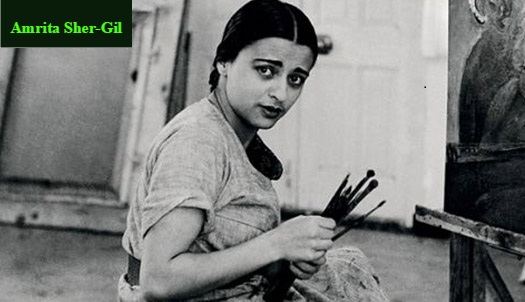
On January 30, 1913, God chose to bestow Modern Indian Art scene with one of his marvelous creations, Amrita Sher-Gil. She was a pioneer in Modern Indian Art against the British landscape. She was bold, impressive and expressive. She chose to paint the life of people and her surroundings. Her work was so intense that it is yet to be paralleled by her successors. Though she is often referred to as India’s Frida Kahlo, but the comparison is not justified. It does not seem to do her justice. She was a magnificent artist in her own sense and does not need comparison to another person for greatness.
Born to a Hungarian mother and Indian father in Budapest, she spent most of her early childhood there. Throughout her life, she travelled between Europe and India. Surrounded with a singer mother and Indologist and painter uncle, Ervin Baktay, she had an early encounter with art. She started showing interest in drawing. She would sketch the objects around her. She would draw on scrap of paper and paint walls.
By the time she was eight years old, her family moved to India. They settled in Shimla. Her mother realized it early that Amrita was destined to be a painter. Hal Bevan Petman was hired to teach her the intricacies of arts. Impressed with her artistic talents, he suggested that she should be trained in fine art in London and Paris. In 1923, Amrita’s mother became acquainted with an Italian sculptor. The artist helped Amrita with her drawing. After he returned to Italy, Amrita and her mother moved to Florence in January 1924 to begin learning at Santa Annunziata school of Art run by Roman Catholics. Amrita always disliked the regulations there. She labeled the school as an: “enormous, elegant but hateful school”. Five months after their arrival at Florence, they returned to India. In 1927, Amrita’s mother took her two daughters on an expedition to Banaras, Calcutta, Darjeeling and Lucknow. In 1927, Amrita’s uncle, Ervin, visited the Sher-Gils in Shimla. Ervin noticed Amrita’s style of art. It was on his encouragement that Amrita began to use live models for her drawings and paintings….a practice that she continued for the rest of her life. Ervin, like Petman and many others, suggested her parents to take her to Paris where the prospects of developing talents were great. In 1929, the family moved to Europe to begin her training, first under Pierre Vaillant and Lucien Simon and later at Ecole des Beaux-Arts. European painters such as Paul Cézanne and Paul Gauguin inspired her. Their influence is exhibited in her early work. Her first major work, Young Girls, got her elected as an Associate of the Grand Salon in Paris in 1933, a rare feat accomplished by any Asian.
Amrita’s heart always belonged to India; for she knew that she belonged to the league of Indian artists and was destined to be a painter here. When she came to India in 1934, her perspective towards life changed. She saw her surroundings with the eyes of an artist. India, the rich country of poor people, helped her find her ‘artistic mission’ of expressing the life of Indian people through her canvas. As an artist, India belonged to her. She took inspiration from rich culture, vivid colors and simplicity of Indians, and undiluted depictions of life by Indian artists. The cave paintings of Ajanta inspired her. Mughal schools of painting and Pahari schools of paintings influenced her work. She was fascinated with India’s richness. She drew inspiration from the works of great two Indian artists – Rabindranath Tagore and Abanindranath Tagore. The selection of women as her muse was inspired from works by Rabindranath while Abanindranath inspired her to play with bright colours. The amalgamation of Western and Indian techniques in her paintings created symphony. Her work was rich and intense. It had mysterious appeal combined with earthiness.
For her achievements and contribution to Modern Indian art, she was recognized by the Indian Government as a National Treasure artist in 1976. The majority of her works are exhibited in the National Gallery of Modern Art in New Delhi. In recognition of her achievement, the Indian Government also named a road, Amrita Sher-Gil Marg, after her. She has always been an inspiration for her Indian artists who succeeded her. Works of artists like Sayed Haider Raza and Arpita Singh drew inspiration from her.
Modern Indian Art witnessed its black day on December 5, 1941. It was the day Amrita passed away at a young age of 28. She was cremated on December 7, 1941. Who would have thought that an artist who was born thousand miles away from India would revolutionize the land with her work for it needed courage to defy social norms, break shackles, come out of four walls, play a vital role in the field of art and inspire the next generation. She was bold and so was her work. Her life was, in Khushwant Singh’s word, a life cut tragically short, but with more colour perhaps than one may find in her work. Her life was cut short, but her legacy continues…





















